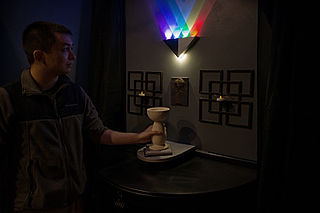
Katamari Damacy is a third-person puzzle-action video game developed and published by Namco for the PlayStation 2. It was released in Japan in March 2004 and in North America in September 2004. Designer Keita Takahashi struggled to pitch the game to Namco's superiors, eventually seeking student aid from the Namco Digital Hollywood Game Laboratory to develop the project for less than US$ 1 million. As director, Takahashi emphasized concepts of novelty, ease of understanding, and enjoyment.

We Love Katamari is a 2005 third-person puzzle-action video game developed and published by Namco for the PlayStation 2. It is the sequel to the 2004 sleeper hit Katamari Damacy. The player controls a diminutive character named the Prince as he rolls around an adhesive ball called a "katamari" to collect increasingly larger objects, ranging from coins to pencils to buildings, in order to build stars as ordered by his father, the King of All Cosmos.
Perplex City was an alternate reality game created by the London-based developer Mind Candy under the direction of the lead producer and designer, Adrian Hon, that ran from April 2005 to February 2007. The first "season" of the game had players looking for "The Receda Cube", a priceless scientific and spiritual artifact to the people of a fictional metropolis known as "Perplex City", which had been stolen and buried somewhere on Earth.

The King of All Cosmos is a character from the Katamari video game series. Created by video game developer Keita Takahashi, he first appears in the 2004 video game Katamari Damacy and is presented as a colossal-sized, god-like monarch who rules over the cosmos, which encompasses all the stars and planets in the sky. In the Katamari series, the King of All Cosmos instructs the franchise's player character, the Prince, to collect and roll up assortments of objects using a ball called a katamari until they are large enough to become celestial bodies. The character has had recurring appearances in the Katamari video game series as a major supporting character, as well as a number of crossover appearances. The King of All Cosmos is generally well received by critics and players, and is often cited as one of the most memorable or influential characters in the history of the video game industry.

Keita Takahashi is a Japanese game designer and artist, his most notable titles being Katamari Damacy and its sequel, We Love Katamari. The original Katamari game was a surprise hit and was praised for its quirkiness, originality, and charm. Takahashi is married to pianist and composer Asuka Sakai, who has worked with Takahashi on various projects.
Escape the room, also known as room escape or escape game, is a subgenre of point-and-click adventure game which requires a player to escape from imprisonment by exploiting their surroundings. The room usually consists of a locked door, objects to manipulate, and hidden clues or secret compartments. The player must use the objects to interact with other items in the room to reveal a way to escape. Escape the room games were born out of freeware browser games created in Adobe Flash, but have since become most popular as mobile games for iOS and Android. Some examples include Crimson Room, Viridian Room, MOTAS, and Droom. The popularity of these online games has led to the development of real-life escape rooms all around the world.

Beautiful Katamari, released in Japan as Beautiful Katamari Damacy, is a video game by Namco Bandai Games for the Xbox 360. Beautiful Katamari is the fourth game in the Katamari series of games following Katamari Damacy, We Love Katamari, and Me & My Katamari.

I Love Katamari, is a third-person puzzle-action video game developed by Namco Bandai Games for iOS. It is a continuation of the Katamari Damacy series of games. It was released worldwide in the App Store on December 14, 2008. In 2010 Namco announced a Windows Phone 7 version of the game. A version was released for Android in 2012 exclusively for Samsung Android devices. In this game, the King of All Cosmos instructs the game's protagonist – the Prince – to gather as many objects as possible to grow a highly adhesive ball called a Katamari large enough so that he can pick up special objects to bring to the King so that he can regain his memory.

Korogashi Puzzle Katamari Damacy is a falling block puzzle video game released by Namco Bandai Games for the Nintendo DSi's DSiWare digital download service. It is a spin-off of the Katamari series. However, it bears little resemblance to the series, resembling Tetris more so. It features similar gameplay to Pac-Attack, another puzzle game created by Namco. It was the first game in the series to appear on a Nintendo platform.
Katamari Damacy is a third-person puzzle-action video game that was published and developed by Namco for the PlayStation 2 video game console. The success of the game led to the release of five sequels in Japan and other territories: We Love Katamari, Me & My Katamari, Beautiful Katamari, Katamari Damacy Mobile, I Love Katamari, and Katamari Forever. It also inspired a spin-off game, Korogashi Puzzle Katamari Damacy.

Nine Hours, Nine Persons, Nine Doors is a visual novel and adventure video game developed by Chunsoft. It is the first installment in the Zero Escape series, and was released in Japan in December 2009 and in North America in November 2010 for the Nintendo DS. The story follows Junpei, a college student who is abducted along with eight other people and forced to play the "Nonary Game", which puts its participants in a life-or-death situation, to escape from a sinking cruise liner. The gameplay alternates between two types of sections: Escape sections, where the player completes puzzles in escape-the-room scenarios; and Novel sections, where the player reads the game's narrative and makes decisions that influence the story toward one of six different endings.

Katamari is a Japanese video game franchise created by Keita Takahashi and developed and published by Namco. The series puts players in control of a young character called The Prince as he assists his father, the King of All Cosmos, in the re-creation of stars and planets by using a ball called a katamari to roll up objects. The first title in the series was Katamari Damacy for the PlayStation 2, which became a cult classic and led to several sequels and spin-offs.

Katamari Amore was a third-person puzzle-action video game that is published and developed by Namco Bandai Games for iOS. With rumors beginning in March 2011, the game was revealed in a pre-release state at E3 2011, and was released to the public on September 29. Katamari Amore is the second game of the Katamari franchise to be released on iOS, and features Game Center integration.

An escape room, also known as an escape game, puzzle room, exit game, or riddle room is a game in which a team of players discover clues, solve puzzles, and accomplish tasks in one or more rooms in order to accomplish a specific goal in a limited amount of time. The goal is often to escape from the site of the game. Most escape games are cooperative but competitive variants exist. Escape rooms became popular in North America, Europe, and East Asia in the 2010s. Permanent escape rooms in fixed locations were first opened in Asia and followed later in Hungary, Serbia, Australia, New Zealand, Russia, and South America.

Zero Escape, formerly released in Japan as Kyokugen Dasshutsu, is a series of adventure games directed and written by Kotaro Uchikoshi. The first two entries in the series, Nine Hours, Nine Persons, Nine Doors (2009) and Zero Escape: Virtue's Last Reward (2012), were developed by Spike Chunsoft, while the third entry, Zero Time Dilemma (2016), was developed by Chime. Zero Escape is published by Spike Chunsoft in Japan, while Aksys Games and Rising Star Games have published the games for North America and Europe respectively.

Wattam is a 2019 puzzle-platform game developed by Funomena and published by Annapurna Interactive. It was designed by Keita Takahashi, better known for creating the Katamari Damacy series, and was released for PlayStation 4 and Windows on December 17.

Windosill is a 2009 puzzle video game by Vectorpark for Microsoft Windows, OS X, Linux, web browsers, and iOS. The player advances through eleven different rooms by interacting with each level's environmental objects. It was developed by Patrick Smith, an artist who taught himself to animate and program the game in Adobe Flash. He was inspired by a variety of painters and artists. The game was first released for Windows, OS X, and web browsers in 2009, and was later ported to the iPad in 2011, with several added features.

Donut County is an indie video game developed by American indie designer Ben Esposito and published by Annapurna Interactive. In the game, the player moves a hole to swallow objects, which makes the hole increase in size. The concept originated in a game jam that used video game pitches from a Twitter account parody of game designer Peter Molyneux, and later added a mechanic similar to that of Katamari Damacy. Other inspirations for the game included Hopi figurines—a theme Esposito later relinquished—and locations from Bruce Springsteen songs. Donut County was released in August 2018 for iOS, macOS, PlayStation 4, and Microsoft Windows platforms while versions for Xbox One and Nintendo Switch were released in December 2018. It also released for Android in December 2020.

Cosmo Gang the Puzzle is a 1992 falling block puzzle arcade video game developed and published by Namco worldwide. The third game in its Cosmo Gang series, succeeding that year's Cosmo Gang the Video, players stack groups of blocks and aliens known as Jammers in a vertical-oriented well. The objective is to clear as many objects on the screen before they reach the top of the screen. Blocks are cleared by aligning them into complete horizontal rows, while Jammers are cleared by defeating them with blue-colored spheres.
Adrian Hon is an English writer and game designer specializing in alternate reality games and transmedia storytelling. He is the CEO and founder of Six to Start, creator of the fitness game Zombies, Run!, and a non-fiction and sci-fi author.
















